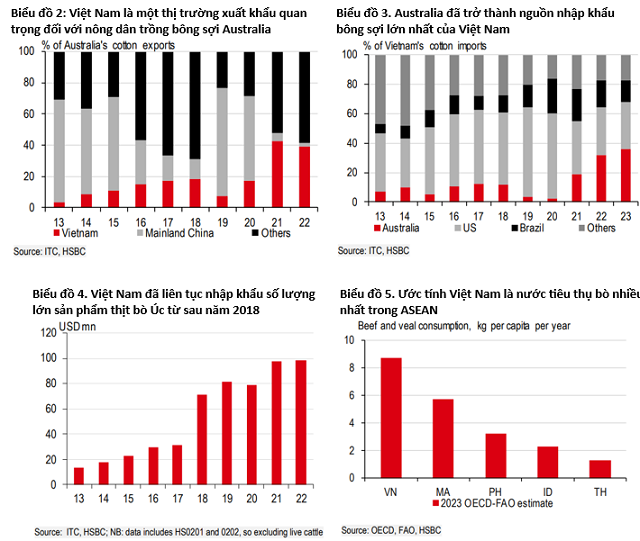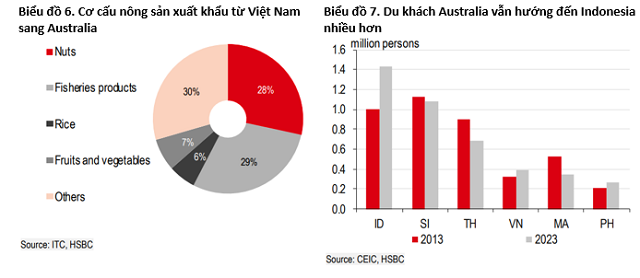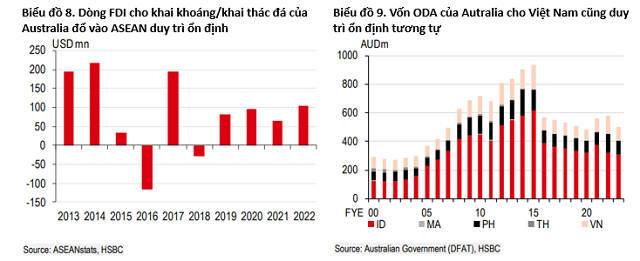The Global Research department of HSBC has just released the report Vietnam at a glance: “Vietnam and Australia: Ready for a new phase” analyzing the relationship between the two countries and the situation in Vietnam in February.
The report was conducted by two experts from HSBC, Yun Liu – an economist in charge of the ASEAN market at HSBC’s Global Research department, and Jamie Culling – an economist in charge of the Australia, New Zealand, and global raw materials market at HSBC’s Global Research department.
The HSBC report evaluates that 2023 is a year of high-level diplomatic activities for Vietnam, in which Vietnam upgrades its diplomatic relations with both the United States and Japan to a “comprehensive strategic partner” level. After signing the agreement to upgrade the ASEAN-Australia-New Zealand Free Trade Area (AANZFTA) in August 2023 and commemorating 50 years of diplomatic relations, Australia has become Vietnam’s next comprehensive strategic partner.
Vietnam – Australia upgrade their relationship to Comprehensive Strategic Partnership
In fact, the governments of both countries have continuously announced the intention to develop their relationship to a new level. This week, Prime Minister Pham Minh Chinh made an official visit to Australia and attended the ASEAN-Australia Special Summit commemorating 50 years of ASEAN-Australia dialogue relationship, along with the leaders of other ASEAN countries. From supplying Vietnam with main primary products to expanding cooperation in new areas, the report points out Australia’s role in Vietnam’s growth story and potential directions for the bilateral relationship.

First and foremost, let’s talk about trade. Bilateral trade has been booming over the past decade, more than doubling to $13.8 billion in 2023. However, part of the increase in trade value since the pandemic comes from higher global prices for raw commodities. Specifically, the two products that saw the most significant increase in value were coal and cotton.

Vietnam is currently Australia’s largest single market for cotton exports, accounting for 40% of Australia’s total cotton exports, twice the market share in 2020. Similarly, Australia accounts for nearly 40% of Vietnam’s cotton imports. Although in terms of market share in total exports (15%), Vietnam’s textile and garment industry has seen a decline in market share in recent years, while the electronics industry has increased to 35%, this is still considered a favorable condition for Australian cotton exporters.
The trade boom not only occurs in the manufacturing sector. A significant increase in discretionary household spending has also stimulated demand for some Australian exports. Specifically, Australia’s beef exports have soared due to the removal of various tariffs under the AANZFTA in 2018. The most encouraging point is the potential consumption of beef in Vietnam. According to the OECD-FAO, by 2030, beef consumption per capita in Vietnam is forecasted to be the highest in ASEAN, opening up opportunities to enhance trade flows.
The HSBC report also highlights that the relationship between the two countries is mutual when Vietnam’s exports to Australia are also increasing. Agriculture is the leading sector, with nuts and seafood accounting for the majority. Cashew nuts imported into Australia are mostly from Vietnam, according to ITC data. To further leverage the bilateral trade agreements between the two countries, such as AANFTA, CPTPP, and RCEP, it is important for Vietnam to improve quality control for agricultural exports, especially in the context of stricter quality standards and regulations in Australia compared to the US and EU in some areas. Currently, only four types of fresh fruits have access to the Australian market, including mangoes, dragon fruits, lychees, and longans, but this also indicates that there are still many great opportunities to expand the market.
Exports of goods are not the only area with potential opportunities, services are also an area for expansion, although the pace is still slow. Last year, ASEAN welcomed 4 million tourists from Australia, but less than 10% of them visited Vietnam. One reason could be related to visas, as Australia does not have a visa waiver policy, and there are still restrictions on the number of flights. The encouraging point is that Vietnam is considering expanding the visa exemption list as well as introducing new flight routes. These are all important initiatives because Australian tourists tend to have longer stays and spend more during their holidays.
Regarding investment, Vietnam has the second-largest rare earth reserves in the world, most of which remain untapped. Australian companies specializing in mining and processing are also seeking to seize this opportunity, with stable FDI flows into this industry in ASEAN in general. As for Vietnam, a prime example is Blackstone Minerals, a company with two bases in Son La province, one for exploration and mining projects and one for deep processing of nickel.
In addition to significant minerals, Australia’s role as Vietnam’s main energy supplier gives it a strategic position that can help promote Vietnam’s energy transition process. Specifically, the Australian Government has committed to providing $105 million in aid to Vietnam in this field.
In addition to trade and FDI, other forms of cooperation are equally important. While Indonesia has long been the main recipient of official development assistance (ODA), Vietnam has also witnessed steady development aid flows. In terms of human resources, there is also a close connection. Australia has long established a milestone in education by establishing the first international university with foreign investment in Vietnam ( RMIT University) since 2000. In the commitment to Vietnam, the Royal Melbourne Institute of Technology (RMIT) in Vietnam has received an additional AUD 250 million investment last year, contributing to the opening of the Innovation and Entrepreneurship Center to help enhance skills for the workforce.
For many years, Australia has played a role in Vietnam’s growth story. In the future, the opportunities arising from new needs will be the foundation for a new chapter in the Vietnam-Australia relationship.






































